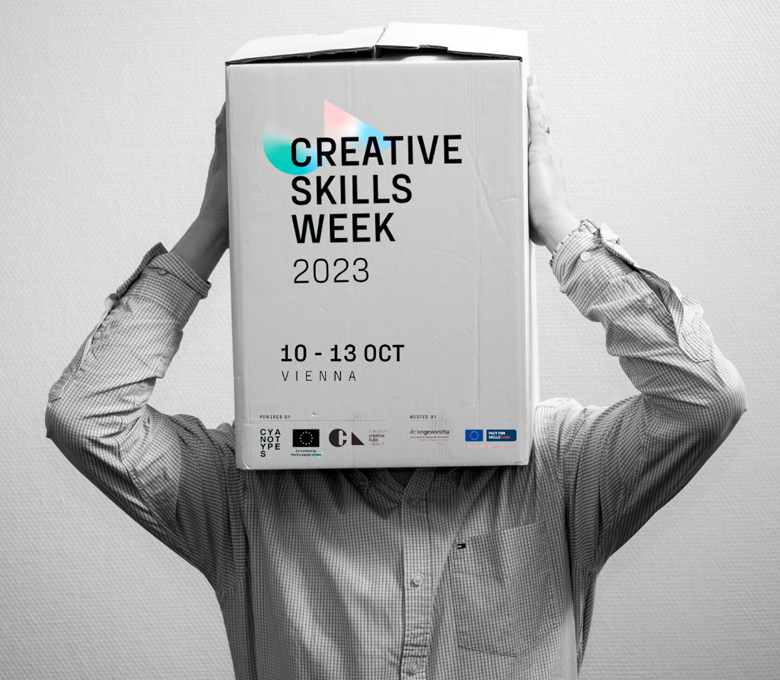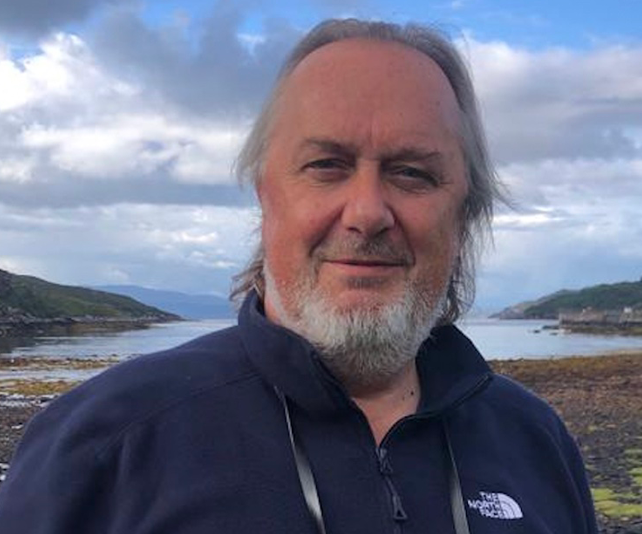CYANOTYPES and the European Creative Hubs Network (ECHN) are launching Creative Skills Week 2023 from 10 to 13 October 2023 in Vienna, Austria, and online. Register here
--
CYANOTYPES is a community of change, a pan-European project that addresses the Cultural and Creative Industries sector’s needs and skills gaps. It brings together a wide variety of organizations, stakeholders, and European networks to address the needs and skills gaps in the Cultural and Creative Industries.

For David Crombie, European coordinator at HKU University of the Arts Utrecht and project leader, it is context that defines creativity more than anything. He thinks the mythical lone creative suffering no longer serves us well when considering individuality versus collectivity.
Skills can and should be learned but our educational systems often discourage innate talents. He thinks that teachers can inspire when curiosity is at the forefront
rather than conformity. Fail gloriously, succeed through practice. Creative journeys arise when learning encourages a richness of talents.
The project he coordinates through HKU University of the Arts Utrecht is called “Cyanotypes”, the first photographic method ever invented to reveal the richness of the “British Algae” as botanist and photographer Anna Atkins did in the first ever photographic book in 1843. For Crombie, the artistic process of cyanotypes serves as a creative blueprint for all industries to come together and identify missing skills. Some may find the name esoteric, but it represents the importance of cross-sector collaboration and the necessity of knowledge through experimentation.
Based on innovative multidisciplinary approaches, CYANOTYPES aims to strengthen the sector’s potential for innovation and competitiveness, which deals as well with challenges presented by, among others, COVID-19, the digital transition, and the green shift. For creativity's future, integrating human and technological insights matters but embracing collective intelligence may matter even more, Crombie thinks.

Why Cyanotypes?
One of the very first photographers back in 1848 was Anna Atkins from the UK. She invented the process of making Cyanotypes, a chemical process like early photography that makes a blueprint. We want to reclaim this artistic, aesthetic process as part of our cultural heritage. Every industry has a blueprint for skills. When we ask the industry to come together, support one another, identify missing skills, and look ahead, we’re creating cyanotypes!
What new nontechnological narratives could be introduced in innovation?
In the arts and creative sectors, we engage heavily with technology - gaming, film, TV. We have a good relationship with tech for innovative products and services. But there's a broader shift, as individuals we barely understand the technological frameworks we're immersed in. They're massive and often overwhelming, and it's hard to find our agency within them, especially collectively. We're surrounded by context-aware tech but aren't context-aware people. It's out of balance. Instead of more tech innovation, we need nontechnological narratives, which are easy to build and people respond well to.
Individuality and collectivity. Are artists still lone wolves? Does creativity depend on collective perception?
There's a myth of the artist suffering alone. Where do these myths come from and why sustain them? The notion of the supreme individual artist may now harm more than help. It's not just artists but intellectuals seen as individual thinkers - our idea of individuality. I don't know what an individual is! We're bundles of selves, already a collective. We label that an individual. The collective in society is powerful and we become more powerful realizing we need a collective agency. For creativity, embracing tech collective intelligence helps. We're no longer the sole source of insight - tech provides powerful insights. I say AI (Artificial Intelligence) needs AI (Artistic Intelligence). We need human-tech assemblages and collective intelligence.
How do you create confidence in the creative process?
Confidence comes and goes, it's not permanent. From a teaching perspective, reinforcement helps, giving inner strength and facilities to assess growth. The OECD 2030 learning framework has an "anticipate, reflect, act" cycle. Learning that builds confidence because you see it works. It's about approaches and techniques in which people understand themselves, take distance, find their space, and combine things. I don’t know if there is a simple answer to that. Or there probably is but I’m not prepared to give it, I don’t have enough confidence to answer that!
What new skills are needed today?
We must radically change practices, rethink learning, and develop new pedagogies. This means challenging linear education models and trying nonlinear, experimental ones focused on surprise, failure, and unlearning. Rather than individual talents, we need collective skills development - learning across disciplines and with human and non-human actors. Education should provide safe spaces to experiment and fail across boundaries.
What new crazy forms can we envision at higher arts education?
I have a relatively concrete vision. I think artists and creatives are perfectly qualified through education and skill sets they are supposed to have or to possess, to manage the multi-level transformations through which our societies are navigating. To understand culture and creativity, not only as a victim of all these processes and make sure that the institutions become climate neutral and environmental friendly, the products are reducing their carbon footprints. There is the expectation that art, culture and creativity can become a driver of this transformation. This means that artists might find themselves in positions where they have to manage or create the transition. The most important thing is that we become aware of this transition, making opportunities rather than accepting the process as a kind of fatality that is unalterable. The role of art, culture and creativity in this context must be to engage, activate and mobilise a much wider framework, something like collective agency to navigate through these transitions and to imagine and discuss different options.
Do art and technology clash?
Technology means art! Brushing tech against the grain and using devices opposite their intent is an artistic privilege and source of innovation. Defining art against tech is defensive and unrealistic. Tech and art grow together, though alienation happens when tech is abstracted from creative practices. Artists need creative confidence to rethink and depoliticise tech.
How do you make failing part of evolving?
Embrace failure. We are all blueprints in that sense. In a constant state of flux. We are constantly failing. We might call it success but actually it might be failure. I don’t know exactly what the difference between success and failure is. The most important thing is that you have a chance to work in creative environments, where you are able to fail. Terribly important. The only way to succeed is if you know how to fail. So become very good at failing and you might succeed. We need creative and experimental spaces where you are allowed to fail. I would say the very definition of a creative space is a space where you are allowed to fail and we shouldn’t squeeze these spaces out of our systems because if you do, we will not succeed at all.
What inspires creativity?
There are lots of different theories about this. One of my favourites is from Steven Johnson who wrote about innovation more than 10 years ago. He gave a very good account about how we join things together and navigate in an innovative manner. A quantum physicist David Bohm wrote an astonishing book on creativity and tried to explain it from that perspective. An evolutionary biologist Edward Willson wrote a book called “The Origins of Creativity” which was an appeal for the world’s thinkers, artists and creatives to get involved, because we need you. You are the only ones who can help save this planet. The one thing that holds different approaches together for me at least is the context. The context defines what is created, as David Byrne argues in his book on how music is made. If you want an innovation system that is more inclusive and takes on board the different needs of different people you need to understand context in a way that most technology doesn’t.
--
Credit: Frank Brouwer - Toning Experiment Cyanotypes, CC2.0 Generic
Myriam Patrou










